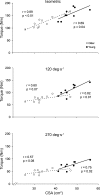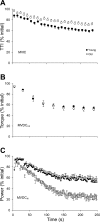Effect of old age on human skeletal muscle force-velocity and fatigue properties
- PMID: 21868683
- PMCID: PMC3220307
- DOI: 10.1152/japplphysiol.00367.2011
Effect of old age on human skeletal muscle force-velocity and fatigue properties
Abstract
It is generally accepted that the muscles of aged individuals contract with less force, have slower relaxation rates, and demonstrate a downward shift in their force-velocity relationship. The factors mediating age-related differences in skeletal muscle fatigue are less clear. The present study was designed to test the hypothesis that age-related shifts in the force-velocity relationship impact the fatigue response in a velocity-dependent manner. Three fatigue protocols, consisting of intermittent, maximum voluntary knee extension contractions performed for 4 min, were performed by 11 young (23.5 ± 0.9 yr, mean ± SE) and 10 older (68.9 ± 4.3) women. The older group fatigued less during isometric contractions than the young group (to 71.1 ± 3.7% initial torque and 59.8 ± 2.5%, respectively; P = 0.02), while the opposite was true during contractions performed at a relatively high angular velocity of 270°·s(-1) (old: 28.0 ± 3.9% initial power, young: 52.1 ± 6.9%; P < 0.01). Fatigue was not different (P = 0.74) between groups during contractions at an intermediate velocity, which was selected for each participant based on their force-velocity relationship. There was a significant association between force-velocity properties and fatigue induced by the intermediate-velocity fatigue protocol in the older (r = 0.72; P = 0.02) and young (r = 0.63; P = 0.04) groups. These results indicate that contractile velocity has a profound impact on age-related skeletal muscle fatigue resistance and suggest that changes in the force-velocity relationship partially mediate this effect.
Figures





References
-
- Allman BL, Rice CL. Incomplete recovery of voluntary isometric force after fatigue is not affected by old age. Muscle Nerve 24: 1156–1167, 2001 - PubMed
-
- Aniansson A, Grimby G, Hedberg M, Rungren A, Sperling L. Muscle function in old age. Scand J Rehabil Med Suppl 6: 43–49, 1978 - PubMed
-
- Bassey EJ, Fiatarone MA, O'Neill EF, Kelly M, Evans WJ, Lipsitz LA. Leg extensor power and functional performance in very old men and women. Clin Sci (Lond) 82: 321–327, 1992 - PubMed
-
- Baudry S, Klass M, Pasquet B, Duchateau J. Age-related fatigability of the ankle dorsiflexor muscles during concentric and eccentric contractions. Eur J Appl Physiol 100: 515–525, 2007 - PubMed
-
- Bemben MG, Massey BH, Bemben DA, Misner JE, Boileau RA. Isometric intermittent endurance of four muscle groups in men aged 20–74 yr. Med Sci Sports Exerc 28: 145–154, 1996 - PubMed
Publication types
MeSH terms
Grants and funding
LinkOut - more resources
Full Text Sources
Medical

